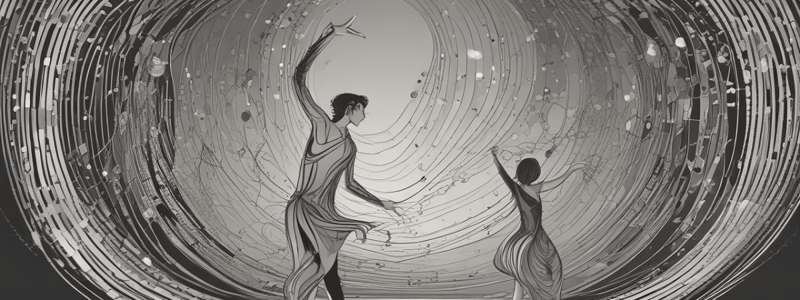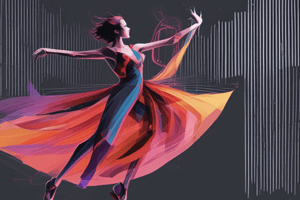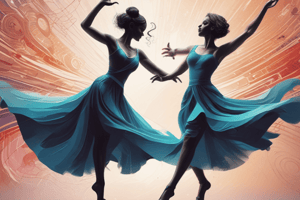Podcast
Questions and Answers
What is the primary function of rhythm in music and dance?
What is the primary function of rhythm in music and dance?
- To guide emotional expression
- To create a visual representation of the music
- To provide structure, timing, and energy (correct)
- To create a harmonious performance
What is rhythm often measured in?
What is rhythm often measured in?
- Melodies per minute
- Seconds per minute
- Harmonies per minute
- Beats per minute (BPM) (correct)
What is the role of rhythm in guiding movement and expression?
What is the role of rhythm in guiding movement and expression?
- It provides a framework for dancers to sync their movements with the music (correct)
- It creates a sense of harmony and balance
- It allows dancers to improvise their movements
- It creates a sense of tension and conflict
What is the benefit of collaborating with musicians or choreographers who have a deep understanding of rhythm?
What is the benefit of collaborating with musicians or choreographers who have a deep understanding of rhythm?
What do dancers use to initiate a movement when they hear a beat in the music?
What do dancers use to initiate a movement when they hear a beat in the music?
What is the result of aligning dance movements with the rhythm of the music?
What is the result of aligning dance movements with the rhythm of the music?
What do dancers pay attention to in addition to the tempo and timing of the music?
What do dancers pay attention to in addition to the tempo and timing of the music?
What is the primary focus of the technique 'Internalize the Rhythm'?
What is the primary focus of the technique 'Internalize the Rhythm'?
What is an effective way to strengthen the connection between music and dance rhythm?
What is an effective way to strengthen the connection between music and dance rhythm?
What is the result of a dancer incorporating rhythmic patterns into their choreography?
What is the result of a dancer incorporating rhythmic patterns into their choreography?
What is the primary goal of incorporating rhythmical patterns and accents into your movement?
What is the primary goal of incorporating rhythmical patterns and accents into your movement?
What is the result of incorporating different dynamics into dance movement?
What is the result of incorporating different dynamics into dance movement?
What is the result of utilizing syncopation in your movement?
What is the result of utilizing syncopation in your movement?
What is essential for dancers to develop in order to fully connect music and dance rhythm?
What is essential for dancers to develop in order to fully connect music and dance rhythm?
What is the purpose of creating musicality in movement?
What is the purpose of creating musicality in movement?
What is the benefit of exploring different rhythmic patterns in dance?
What is the benefit of exploring different rhythmic patterns in dance?
What is the effect of emphasizing unexpected beats within a rhythmical pattern?
What is the effect of emphasizing unexpected beats within a rhythmical pattern?
What is the purpose of incorporating isolations and body percussion into dance movement?
What is the purpose of incorporating isolations and body percussion into dance movement?
What is the first step in integrating rhythmical patterns and accents into your choreography?
What is the first step in integrating rhythmical patterns and accents into your choreography?
What is the definition of rhythm in dance?
What is the definition of rhythm in dance?
What is the key to mastering the art of incorporating rhythmical patterns and accents into your movement?
What is the key to mastering the art of incorporating rhythmical patterns and accents into your movement?
What is the result of exposing oneself to different genres of music?
What is the result of exposing oneself to different genres of music?
What is the result of incorporating rhythmical patterns and accents into your movement?
What is the result of incorporating rhythmical patterns and accents into your movement?
What is the purpose of allowing the energy of the pattern to guide your movements?
What is the purpose of allowing the energy of the pattern to guide your movements?
What is the role of rhythm in dance?
What is the role of rhythm in dance?
What is the effect of experimenting with different movement qualities, such as sharp, flowing, staccato, or sustained?
What is the effect of experimenting with different movement qualities, such as sharp, flowing, staccato, or sustained?
What is the primary goal of incorporating rhythmical patterns and accents into dance movement?
What is the primary goal of incorporating rhythmical patterns and accents into dance movement?
What is an essential element to grasp when working with rhythmical patterns?
What is an essential element to grasp when working with rhythmical patterns?
What is the purpose of accentuation in dance movement?
What is the purpose of accentuation in dance movement?
How can you develop your personal artistic expression in dance?
How can you develop your personal artistic expression in dance?
What is the benefit of practicing with different genres of music?
What is the benefit of practicing with different genres of music?
How can you improve your rhythmic abilities?
How can you improve your rhythmic abilities?
What is a key element in mastering the art of using rhythm to enhance movement quality?
What is a key element in mastering the art of using rhythm to enhance movement quality?
What is the role of the body in dance movement?
What is the role of the body in dance movement?
How can you enhance your ability to perform on the spot?
How can you enhance your ability to perform on the spot?
What is the benefit of learning from other dancers and performers?
What is the benefit of learning from other dancers and performers?
Flashcards are hidden until you start studying
Study Notes
Rhythm and Movement
- Rhythm is the backbone of both music and dance, providing structure, timing, and energy.
- Understanding rhythm is essential for any dancer, as it guides movement and expression.
- Rhythm can be defined as the pattern of sounds and silences in music, and it is often measured in beats per minute (BPM).
The Connection between Music and Dance Rhythm
- Music and dance rhythm are closely intertwined, as both rely on timing and coordination.
- When a dancer hears a beat in the music, they can use it as a cue to initiate a movement.
- By aligning their movements with the rhythm, dancers can effectively convey the emotions and intentions of the music.
Developing Musicality
- To fully connect music and dance rhythm, dancers must develop their musicality.
- This involves actively listening to the music and internalizing its rhythms and melodies.
- By cultivating their musical ear, dancers can become more attuned to the nuances of the music, allowing them to respond and adapt their movements accordingly.
Strengthening the Connection between Music and Dance Rhythm
- An effective way to strengthen the connection between music and dance rhythm is through practice and repetition.
- Dancers can spend time practicing their routines while listening to the music, experimenting with different movements and accents to find the most suitable interpretation.
- Collaborating with musicians or choreographers who have a deep understanding of rhythm can also provide valuable insights and guidance.
Using Rhythm to Enhance Movement Quality
- Rhythm plays a vital role in dance and movement, as it adds a sense of musicality and synchronization to the performance.
- By incorporating rhythm into their dance routine, dancers can greatly enhance the quality of their movement.
Techniques for Enhancing Movement Quality
- Internalizing the rhythm of the music by listening to the beats and accents.
- Focusing on dynamics, including variations in tempo, intensity, and energy.
- Creating musicality in movement by interpreting and expressing the music through movement.
- Exploring different rhythmic patterns, such as syncopation, polyrhythm, and cross-rhythms.
- Incorporating isolations and body percussion to add depth and interest to the dance routine.
- Improvising and experimenting with different movement qualities to develop personal artistic expression.
- Practicing with different genres of music to broaden understanding of rhythm and movement.
Utilizing Rhythmical Patterns and Accents to Enhance Movement Quality
- Rhythmical patterns are sequences of regular and irregular beats or sounds that create a musical structure.
- Accentuation provides contrast and highlights specific moments in the movement sequence.
- Emotional and physical interpretation of rhythmical patterns and accents can add depth to the performance.
- Syncopation creates unexpected moments of tension and release within the movement.
- Integration of rhythmical patterns and accents into the choreography or movement sequence is crucial.
- Practice, exploration, and collaboration are essential for mastering the art of incorporating rhythmical patterns and accents into movement.
Studying That Suits You
Use AI to generate personalized quizzes and flashcards to suit your learning preferences.




